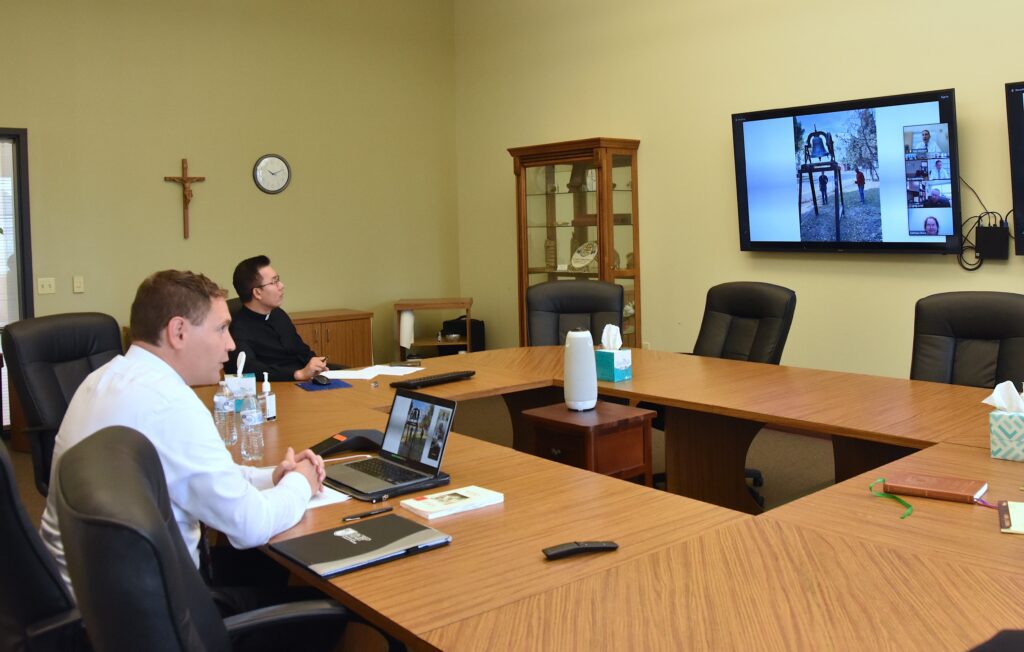“It was an unexpected joy to find out that my historical research has dovetailed with the history of the Dehonians in the United States.”
-Dr. Paul Monson, SHSST Vice President of Intellectual Formation and Academic Dean
This year we celebrate the centenary of Dehonian ministry in the United States. During his presentation today (Aug. 9) to SCJs and collaborators, Dr. Paul Monson, Vice President of Intellectual Formation and Academic Dean at Sacred Heart Seminary and School of Theology, suggested that the SCJ legacy is one that is actually built upon that of another religious community: the Benedictines.
Besides his administrative duties at SHSST, Dr. Monson is also an Associate Professor of Church History. His doctoral dissertation was on the adaption of the Rule of St. Benedict in the United States.

“It was an unexpected joy to find out that my historical research has dovetailed with the history of the Dehonians in the United States,” he said. “Little did I know that the history of the Benedictines would help to set the foundation that I and many others here have inherited through various Dehonian apostolates in the United States.”
“Benedictine Dehonians: A Window into SCJ History in South Dakota,” was the title of Dr. Monson’s presentation. It was one in what has become a series of hour-long conferences on Dehonian themes held via Zoom for SCJs and collaborators. There were over 100 participants in today’s presentation.
Dr. Monson has done extensive research on Bishop Martin Marty, a Benedictine monk who volunteered to go to the Dakota Territory in 1876 to establish the Church among Native Americans. Bishop Marty baptized Sitting Bull upon his conversion to Christianity.
The origin story of the Dehonians in the United States often begins with the bishop of what was then the diocese of Lead, SD, entrusting St. Mary’s parish in Lower Brule to the SCJs. It is Fr. Mathias Fohrman’s first Mass in that parish, celebrated in 1923, that is considered the starting point of Dehonian ministry in the United States.
However, Dr. Monson noted that it was the Benedictines who were responsible for much of the establishment of the Church and Catholic outreach in the Dakotas before the presence of the SCJs.
Bishop Marty put a priority on the concept of “stability.” It wasn’t just the stability of institutions that was important to him, but “the idea of stability of presence, a stability of place,” said Dr. Monson.
St. Joseph’s Indian School, added Dr. Monson, is both an example of that stability, and one of the significant reasons that pastoral ministry begun by the Benedictines can continue.
“The legacy of Bishop Marty, his vision of stability and of an emphasis on family, lives on in St. Joseph’s,” said Dr. Monson. “Without St. Joseph’s stability, St. Mary’s parish most likely would not have lasted until today.”
Dr. Monson also spoke of St. Joseph’s focus on the family. In the early 1980s, student dormitories at St. Joseph’s were closed in favor of family-style units where students live in small groups with a set of house parents while maintaining close contact with their families back home. This too – the emphasis on family – is also a part of the legacy of Bishop Marty.
“Two years after Bishop Marty arrived in the Dakotas in 1876, Fr. Dehon established the Priests of the Sacred Heart,” said Dr. Monson.
Eventually, the dreams of both men, dreams of ministry and service, became interconnected in South Dakota.
A recording of Dr. Monson’s presentation will be available within the next few days.

Pictured at the top of the page: Dr. Monson speaks with Fr. Wayne Jenkins, SCJ and Fr. Ed Zemlik, SCJ, of the Province Archives, along with Fr. Vien Nguyen, SCJ

